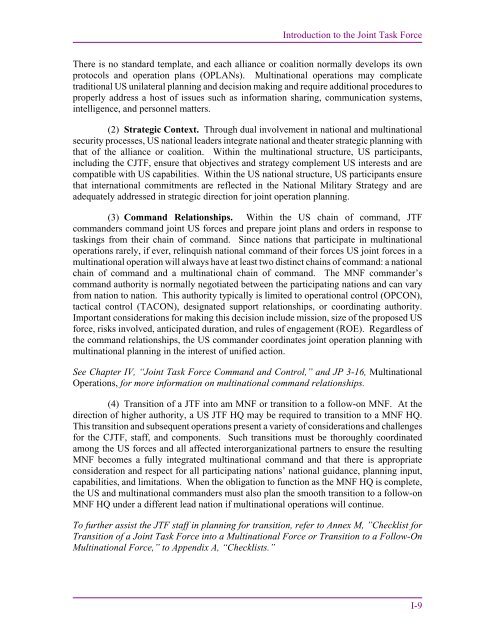JP 3-33, Joint Task Force Headquarters - Defense Innovation ...
JP 3-33, Joint Task Force Headquarters - Defense Innovation ...
JP 3-33, Joint Task Force Headquarters - Defense Innovation ...
Create successful ePaper yourself
Turn your PDF publications into a flip-book with our unique Google optimized e-Paper software.
Introduction to the <strong>Joint</strong> <strong>Task</strong> <strong>Force</strong><br />
There is no standard template, and each alliance or coalition normally develops its own<br />
protocols and operation plans (OPLANs). Multinational operations may complicate<br />
traditional US unilateral planning and decision making and require additional procedures to<br />
properly address a host of issues such as information sharing, communication systems,<br />
intelligence, and personnel matters.<br />
(2) Strategic Context. Through dual involvement in national and multinational<br />
security processes, US national leaders integrate national and theater strategic planning with<br />
that of the alliance or coalition. Within the multinational structure, US participants,<br />
including the CJTF, ensure that objectives and strategy complement US interests and are<br />
compatible with US capabilities. Within the US national structure, US participants ensure<br />
that international commitments are reflected in the National Military Strategy and are<br />
adequately addressed in strategic direction for joint operation planning.<br />
(3) Command Relationships. Within the US chain of command, JTF<br />
commanders command joint US forces and prepare joint plans and orders in response to<br />
taskings from their chain of command. Since nations that participate in multinational<br />
operations rarely, if ever, relinquish national command of their forces US joint forces in a<br />
multinational operation will always have at least two distinct chains of command: a national<br />
chain of command and a multinational chain of command. The MNF commander’s<br />
command authority is normally negotiated between the participating nations and can vary<br />
from nation to nation. This authority typically is limited to operational control (OPCON),<br />
tactical control (TACON), designated support relationships, or coordinating authority.<br />
Important considerations for making this decision include mission, size of the proposed US<br />
force, risks involved, anticipated duration, and rules of engagement (ROE). Regardless of<br />
the command relationships, the US commander coordinates joint operation planning with<br />
multinational planning in the interest of unified action.<br />
See Chapter IV, “<strong>Joint</strong> <strong>Task</strong> <strong>Force</strong> Command and Control,” and <strong>JP</strong> 3-16, Multinational<br />
Operations, for more information on multinational command relationships.<br />
(4) Transition of a JTF into am MNF or transition to a follow-on MNF. At the<br />
direction of higher authority, a US JTF HQ may be required to transition to a MNF HQ.<br />
This transition and subsequent operations present a variety of considerations and challenges<br />
for the CJTF, staff, and components. Such transitions must be thoroughly coordinated<br />
among the US forces and all affected interorganizational partners to ensure the resulting<br />
MNF becomes a fully integrated multinational command and that there is appropriate<br />
consideration and respect for all participating nations’ national guidance, planning input,<br />
capabilities, and limitations. When the obligation to function as the MNF HQ is complete,<br />
the US and multinational commanders must also plan the smooth transition to a follow-on<br />
MNF HQ under a different lead nation if multinational operations will continue.<br />
To further assist the JTF staff in planning for transition, refer to Annex M, ”Checklist for<br />
Transition of a <strong>Joint</strong> <strong>Task</strong> <strong>Force</strong> into a Multinational <strong>Force</strong> or Transition to a Follow-On<br />
Multinational <strong>Force</strong>,” to Appendix A, “Checklists.”<br />
I-9

















